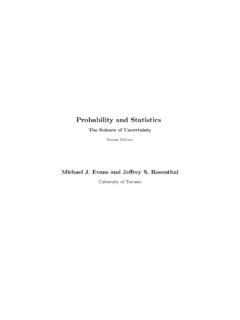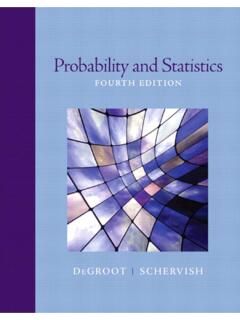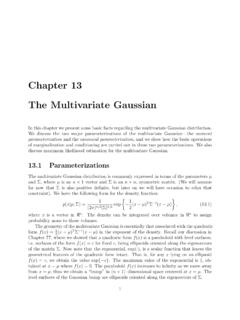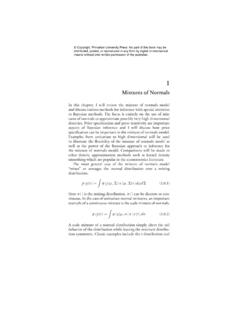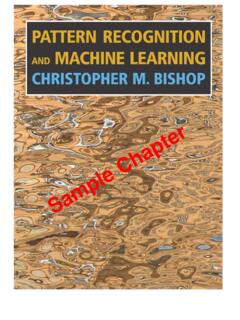Transcription of CHAPTER 3 COMMONLY USED STATISTICAL TERMS
1 145 CHAPTER 3 COMMONLY USED STATISTICAL TERMST here are many statistics used in social science research and evaluation. The two main areas of statistics are descriptive and inferential. The third class of statistics is design and experimental statistics. Descriptive statistics involve the tabulating, depicting, and describing of col-lections of data. These data may be either quantitative or qualitative. They provide a picture or description of the properties of data collected in order to summarize them into manageable form. Inferential statistics are a formalized body of techniques that infer the properties of a larger collection of data from the inspection of that collection. They build on these statistics as they infer the properties of samples to various populations. Design and analysis statistics were developed for the discovery and confirmation of causal relationships among vari-ables in social science experiments.
2 They use a variety of STATISTICAL tests related to aspects such as prediction and hypothesis testing. Experimental analysis is related to As in the previous glossary CHAPTER , if you are looking for a term and it is not here, please send it to my e-mail address, with the subject line: New STATISTICAL TERMS Needed. It will then be added in the next Pocket Glossary for COMMONLY Used Research Termscomparisons, variance, and ultimately testing whether variables are significant between each other. The lat-ter two types of statistics are usually either parametric or nonparametric. The importance of statistics in the research process is sometimes exaggerated. Thus, a highly sophisticated STATISTICAL analysis rarely, if ever, compen-sates for a poorly conceived project, a poorly constructed research design, or an inaccurate data collection instru-ment. Thus, statistics certainly may aid the researcher but are never a substitute for good, sound thinking and atten-tion to the scientific method and research process.
3 For researchers, then, statistics are simply a tool to help them study the phenomena they are interested STATISTICSM easures of Central TendencyMean, arithmetic mean (X or M): The sum of the scores in a distribution divided by the number of scores in the distri-bution. It is the most COMMONLY used measure of central tendency. It is often reported with its companion statistic, the standard deviation, which shows how far things vary from the (Mdn): The midpoint or number in a distribution having 50% of the scores above it and 50% of the scores below it. If there are an odd number of scores, the median is the middle (Mo): The number that occurs most frequently in a distribution of scores or numbers. In some fields, notably education, sample data are often called scores, and the sample mode is known as the modal Used STATISTICAL TERMS 147 Measures of VariabilityInterquartile range (IQR): A measure of STATISTICAL dispersion being equal to the difference between the third and first quartiles.
4 The first quartile (designated Q1) is the lower and cuts off the lowest 25% of data (the 25th percentile); the second quartile (Q2), or the median, cuts the data set in half (the 50th percentile); and the third quartile (Q3) cuts off highest 25% of data, or the lowest 75% (the 75th percentile).Range (Ra): The difference between the highest and lowest scores in a distribution ; a measure of variability. Standard deviation (SD): The most stable measure of vari-ability, it takes into account each and every score in a normal distribution . This descriptive statistic assesses how far individual scores vary in standard unit lengths from its midpoint of 0. For all normal distributions, 95% of the area is within standard deviations of the (SD2): A measure of the dispersion of a set of data points around their mean value. It is a mathemati-cal expectation of the average squared deviations from the STATISTICAL TestsTests concerned with using selected sample data compared with population data in a variety of ways are called inferen-tial STATISTICAL tests.
5 There are two main bodies of these tests. The first and most frequently used are called parametric sta-tistical tests. The second are called nonparametric tests. For each parametric test, there may be a comparable nonpara-metric test, sometimes even two or three. Parametric tests are tests of significance appropriate when the data represent an interval or ratio scale of measurement 148 Pocket Glossary for COMMONLY Used Research Termsand other specific assumptions have been met, specifically, that the sample statistics relate to the population parameters, that the variance of the sample relates to the variance of the population, that the population has normality, and that the data are statistically tests are STATISTICAL tests used when the data represent a nominal or ordinal level scale or when assumptions required for parametric tests cannot be met, specifically, small sample sizes, biased samples, an inabil-ity to determine the relationship between sample and population, and unequal variances between the sample and population.
6 These are a class of tests that do not hold the assumptions of the list of STATISTICAL TERMS below, when the test is a parametric test, the designation of *PT will be used at the end of the definition. Conversely, when the test is a nonpara-metric test, the designation of *NPT will be used at the end of the TermsAlpha coefficient ( ): See Cronbach s alpha of covariance (ANCOVA): A STATISTICAL technique for equating groups on one or more variables when testing for STATISTICAL significance using the F-test statistic. It adjusts scores on a dependent variable for initial differences on other variables, such as pretest performance or IQ. *PTAnalysis of variance (ANOVA): A STATISTICAL technique for determining the STATISTICAL significance of differences among means; it can be used with two or more groups and uses the F-test statistic. *PTAutoregressive integrated moving average (ARIMA): This statistic is a Box-Jenkins approach to time series analy-sis.
7 It tests for changes in the data patterns pre- and COMMONLY Used STATISTICAL TERMS 149postintervention within the context of analyzing the out-comes of a time series test: An exact test of the STATISTICAL significances of derivations from a theoretically expected distribution of observations into two categories. *NPTChi-square ( ): A nonparametric test of STATISTICAL signifi-cance appropriate when the data are in the form of fre-quency counts; it compares frequencies actually observed in a study with expected frequencies to see if they are significantly different. *NPTC ochran s Q: Used to evaluate the relation between two variables that are measured on a nominal scale. One of the variables may even be dichotomous or consisting of only two possible values. *NPTC oefficient of determination (r ): The square of the correla-tion coefficient (r), it indicates the degree of relationship strength by potentially explained variance between two s d: A standardized way of measuring the effect size or difference by comparing two means by a simple math formula.
8 It can be used to accompany the reporting of a t-test or ANOVA result and is often used in meta-anal-ysis. The conventional benchmark scores for the magni-tude of effect sizes are as follows: small, d = ; medium, d = ; large, d = *NPTC ohen s kappa ( ): A STATISTICAL measure of interrater agree-ment for qualitative (categorical) items. Scores range from to *NPTC onfidence interval (CI): Quantifies the uncertainty in mea-surement. It is usually reported as a 95% CI, which is the range of values within which it can be 95% certain that the true value for the whole population lies. For example, 150 Pocket Glossary for COMMONLY Used Research Termsfor a number needed to treat (NNT) of 10 with a 95% CI of 5 to 15, there would be 95% confidence that the true NNT value lies between 5 and coefficient (r): A decimal number between and that indicates the degree to which two quanti-tative variables are related. The most common one used is the Pearson Product Moment correlation coefficient or just the Pearson s alpha coefficient ( ): A coefficient of consistency that measures how well a set of variables or items measures a single, unidimensional, latent construct in a scale or inven-tory.
9 Alpha scores are conventionally interpreted as follows: high, ; medium, to ; and low, to frequency distribution : A graphic depiction of how many times groups of scores appear in a t-test: A data analysis procedure that assesses whether the means of two related groups are statistically dif-ferent from each other, for example, one group s mean score (time one) compared with the same group s mean score (time two). It is also called the paired samples t-test. *PTEffect size ( ): Any measure of the strength of a relationship between two variables. Effect size statistics are used to assess comparisons between correlations, percentages, mean differences, probabilities, and so ( ): An index that indicates the degree of a curvilinear (F): A parametric STATISTICAL test of the equality of the means of two or more samples. It compares the means and variances between and within groups over time. It is also called analysis of variance (ANOVA).
10 *PTFactor analysis: A STATISTICAL method for reducing a set of variables to a smaller number of factors or basic COMMONLY Used STATISTICAL TERMS 151components in a scale or instrument being analyzed. Two main forms are exploratory (EFA) and confirmatory fac-tor analysis (CFA). *PTFisher s exact test: A nonparametric STATISTICAL significance test used in the analysis of contingency tables where sample sizes are small. The test is useful for categori-cal data that result from classifying objects in two dif-ferent ways; it is used to examine the significance of the association (contingency) between two kinds of classifications. *NPTF riedman two-way analysis of variance: A nonparametric inferential statistic used to compare two or more groups by ranks that are not independent. *NPTG2: This is a more conservative goodness-of-fit statistic than the and is used when comparing hierarchical models in a categorical contingency (two-by-two) table.










